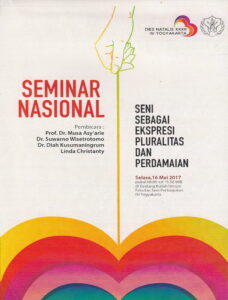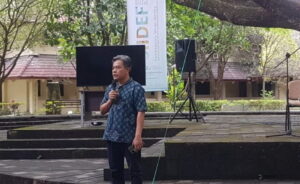 DESPRO NEWS, (May 17, 2017) In a series of events of the XXXIII Anniversary or Dies Natalis of Institut Seni Indonesia Yogyakarta, a national seminar on Tuesday, May 16, 2017 was held at the Public Lecture Building of the Faculty of Performing Arts ISI Yogyakarta, Jl Parangtritis KM 6.5 Sewon-Bantul, Yogyakarta. The National Seminar entitled "Art as an Expression of Plurality and Peace" was opened by the Rector of ISI Yogyakarta, Prof. Dr. M. Agus Burhan, M.Hum.
DESPRO NEWS, (May 17, 2017) In a series of events of the XXXIII Anniversary or Dies Natalis of Institut Seni Indonesia Yogyakarta, a national seminar on Tuesday, May 16, 2017 was held at the Public Lecture Building of the Faculty of Performing Arts ISI Yogyakarta, Jl Parangtritis KM 6.5 Sewon-Bantul, Yogyakarta. The National Seminar entitled "Art as an Expression of Plurality and Peace" was opened by the Rector of ISI Yogyakarta, Prof. Dr. M. Agus Burhan, M.Hum.
The committee of Dies Natalis XXXIII this time invited 4 speakers, namely Prof. Dr. Musa Asy'arie, Dr. Suwarno Wisetrotomo, Dr. Diah Kusumaningrum, and Linda Christanty. In his paper, Prof. Dr. Musa Asy'arie, former Rector of UIN Sunan Kalijaga and former Expert Staff of the Minister of Communication and Information of the Republic of Indonesia said that plurality is the reality of animate and inanimate objects in the universe. Everything in it occurs as a result of the creative process, either creation from nothing (absolute) or from what exists (relative). The relative creative subject creates culture, and art is part of that. Art is part of the effort to elevate humanity. Today's challenges are hedonism, pragmatism and consumerism. Therefore, art is important to prevent culture from falling into these three challenges.
In line with that, Dr. Suwarno Wisetrotomo, Head of the Master of Art Creation and Study program at ISI Yogyakarta Postgraduate Program who is also a curator at the National Gallery, said that plurality is a necessity. Plurality is complex, dynamic, full of tension, as well as challenges. Therefore, strategic and creative efforts are needed by creating channels to express various interests. Without channels as a way and space for expression, aspirations become stuck, and have the potential to explode in the form of anarchic and destructive actions. Art / art works / art education / art is one of these channels. Art teaches us an attitude and understanding of depth, the drama of life, democracy, critical attitudes, and the spirit of liberation.
In the second session, through her paper entitled "Peaceful Art, Artful Peace", Dr. Diah Kusumaningrum, a lecturer at the UGM International Relations Study Program who is active as a researcher at the UGM Center for Security and Peace Studies, said that Art and peace are often conceptualized as "means and ends", where art is positioned as a tool to realize peace. With this perspective, the attention of academics and practitioners tends to focus on the agenda of increasing the effectiveness of art. The three questions that form the basis of his paper are How can art offer a critical reading of structural and cultural violence in society? How can art touch the sense of humanity, justice, and solidarity? And how can art inspire people to engage in creative work to promote change?
Linda Christanty, a writer and journalist, as the last speaker said that art is actually a flexible medium and, as such, it provides a very wide possibility to be filled with messages that reunite what is separated or scattered. His experience of working in the post-conflict atmosphere of Aceh made him realize that politics and religion tend to separate communities, but art can bring them together. Art has participated in bridging reconciliation outside the peace negotiation tables. Performing arts that involve the masses or citizens as audiences melt tensions and erode the distance built up due to conflict or war situations, as well as being a venue for reconciliation. trauma healing. Literary or photographic works that provide a personal space for individuals to reflect or contemplate can take on the same role.
The seminar, which was attended by lecturers from all faculties at ISI Yogyakarta, was also attended by several ISI Yogyakarta students. Among the seminar participants, there were lecturers from the ISI Yogyakarta Product Design Study Program, including Rahmawan D. Prasetya, S.Sn., M.Si., Drs. Endro Trisusanto, M.Sn., Nor Jayadi, S.Sn., M.A., and Sekartaji Suminto, S.Sn., M.Sn.
